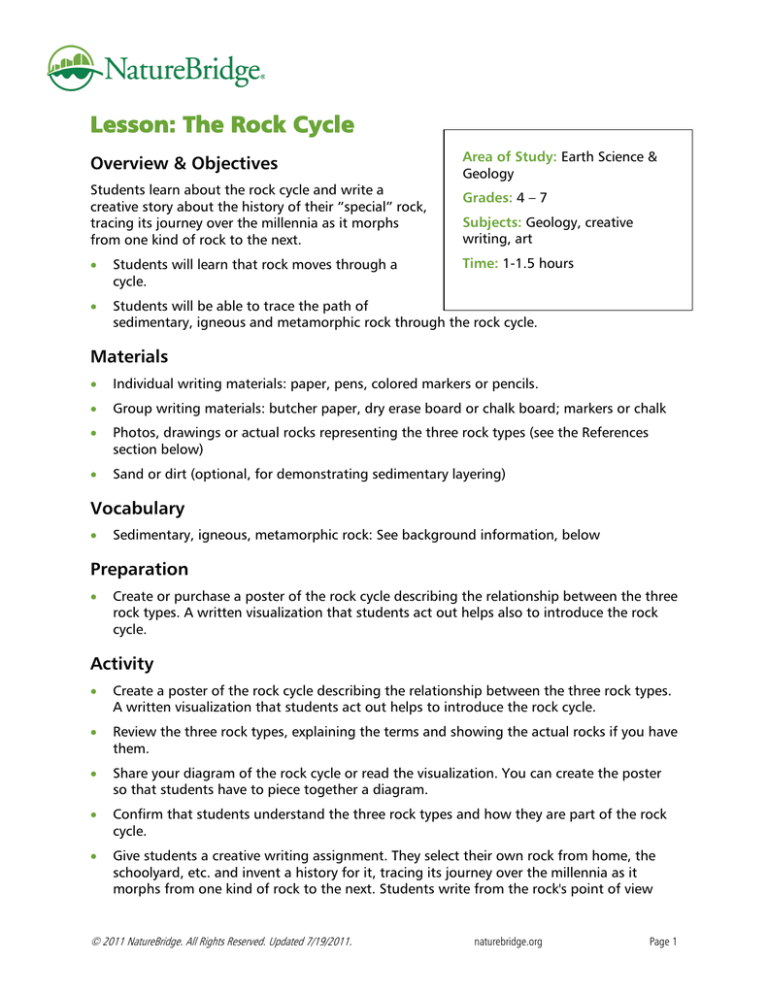
Lesson: The Rock Cycle
Overview & Objectives
Students learn about the rock cycle and write a
creative story about the history of their “special” rock,
tracing its journey over the millennia as it morphs
from one kind of rock to the next.
Area of Study: Earth Science &
Geology
Grades: 4 – 7
Subjects: Geology, creative
writing, art
Time: 1-1.5 hours
•
Students will learn that rock moves through a
cycle.
•
Students will be able to trace the path of
sedimentary, igneous and metamorphic rock through the rock cycle.
Materials
•
Individual writing materials: paper, pens, colored markers or pencils.
•
Group writing materials: butcher paper, dry erase board or chalk board; markers or chalk
•
Photos, drawings or actual rocks representing the three rock types (see the References
section below)
•
Sand or dirt (optional, for demonstrating sedimentary layering)
Vocabulary
•
Sedimentary, igneous, metamorphic rock: See background information, below
Preparation
•
Create or purchase a poster of the rock cycle describing the relationship between the three
rock types. A written visualization that students act out helps also to introduce the rock
cycle.
Activity
•
Create a poster of the rock cycle describing the relationship between the three rock types.
A written visualization that students act out helps to introduce the rock cycle.
•
Review the three rock types, explaining the terms and showing the actual rocks if you have
them.
•
Share your diagram of the rock cycle or read the visualization. You can create the poster
so that students have to piece together a diagram.
•
Confirm that students understand the three rock types and how they are part of the rock
cycle.
•
Give students a creative writing assignment. They select their own rock from home, the
schoolyard, etc. and invent a history for it, tracing its journey over the millennia as it
morphs from one kind of rock to the next. Students write from the rock's point of view
© 2011 NatureBridge. All Rights Reserved. Updated 7/19/2011.
naturebridge.org
Page 1
and incorporate the terms igneous, sedimentary, metamorphic and rock cycle. Students
illustrate their story with pictures.
•
Suggested questions for the writing assignment include: What is your rock's name? Who
did the rock meet along the way? Where has it been and what did it feel like in these
places? What great historical events has it witnessed? Have people used it for anything
along the way? Where does it sit today?
Extensions
•
Connect the rock cycle to plant or animal life cycles, the water cycle, or other natural
cycles.
•
Study how the rock cycle affects living things.
•
Explore the geological history and features of your own area.
•
Examine the earth's geologic timeline and compare it to the timeline of known human
history. How has geology affected human history?
Background
Three rock types are part of the rock cycle: igneous, sedimentary and metamorphic rock.
Igneous rock originates from volcanoes. Melted rock from the earth's core, known as magma,
rises through weak points in the earth's crust. When magma rises slowly, it is known as
intrusive rock. When magma rises slowly, it is known as intrusive rock. Once this melted rock
is on the surface, it is known as lava. An example of igneous rock is obsidian.
Sedimentary rock is formed when millions of tiny fragments (sand, silt and mud) are released
from larger rock formations through erosion or weathering. They then form layers of
sediment so thick and pressurized that they solidify into new rock. This process occurs near or
at the earth's surface. Sandstone is one kind of sedimentary rock.
Metamorphic rock is formerly igneous or sedimentary rock that changes into new rock as a
result of extreme heat and pressure beneath the earth's surface. Marble is an example of
metamorphic rock.
The rock cycle is the path that rock takes as it goes from igneous to sedimentary to
metamorphic, and eventually back to igneous. Visualize a rock beginning as magma, going
through a volcanic process to become an igneous rock. After millions of years this rock breaks
down into small sand particles through weathering and erosion. These particles eventually
pile up with others and under pressure form sedimentary rock. Eventually this rock is pushed
down deeper into the earth and changes in intense heat and pressure into metamorphic rock.
After millions of years, the cycle begins again.
Standards
National standards
California standards
4th grade
Life science 4
6th grade
© 2011 NatureBridge. All Rights Reserved. Updated 7/19/2011.
naturebridge.org
Page 2
Earth science 1, 2
7th grade
Earth science 4
Resources
Physical Geology by Brian Skinner and Stephen Porter
Essentials of Geology by Reed Wicander and James Monroe
United States Geology Survey, Educational Resources
© 2011 NatureBridge. All Rights Reserved. Updated 7/19/2011.
naturebridge.org
Page 3





